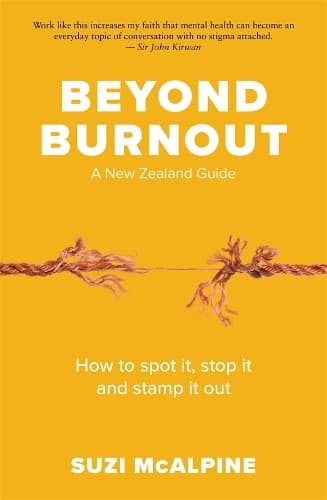Review: Beyond Burnout: A New Zealand Guide
Reviewed by Lauren Keenan
Suzi McAlpine is an executive coach. She is also the creator of an online leadership programme for organisations seeking to equip their leaders with the tools required to create healthy work environments. McAlpine is also a mother who realised she was suffering from burnout when, one morning, she felt too busy to hug her seven-year-old son. This combination of professional expertise and lived experience has led to a book that delivers exactly what is promised in the title: a useful guide to spotting burnout, stopping it, and – eventually – stamping it out.
Beyond Burnout covers the essentials of burnout: why it’s a bad thing for both individuals and organisations, myths surrounding burnout, what burnout actually means (including a very useful analysis of how burnout differs from depression and stress), who is most at risk and what might cause burnout to occur. It then concludes with advice on what both organisations and individuals can do about it.
McAlpine’s analysis and conclusions are supported by detailed research including some fairly harrowing statistics about how endemic burnout is in some industries (in particular the medical profession), how many employees have experienced burnout themselves and how the negative consequences of burnout are far-reaching for both individuals and organisations alike.
The many interesting factoids within the pages of Beyond Burnout mean that my copy is filled with so many coloured flags it looks like it belongs at a fairground. Some concepts, however, are particularly worthy of mention. The first was McAlpine’s metaphor of the sick fish in a contaminated fishbowl: that burnout cannot be viewed as a problem that sits on the shoulders of individuals (the sick fish) when it might be the eco-system (the organisation) that needs treatment.
This focus on the problem of burnout at a systemic rather than individual level is a welcome antidote to the toxic positivity that often overestimates an individual’s ability to change their situation when, like the poor sick fish, the problem might be in the water. I particularly liked McAlpine’s statement in the section about what we can do to address burnout: “We’ve seen a proliferation of yoga classes, mindfulness training and fruit bowls in the lunchroom. We’ve seen resilience courses and fitness programmes galore. I don’t want to diss these things. They all play their part. But burnout won’t be fixed by a fruit bowl.”
The second concept I found particularly useful is learning how to work within your “circle of control” as opposed to your “circle of influence” or “circle of concern”. Building on that is understanding recovery from burnout might take time, identifying the root cause of burnout, practicing more self-care and learning how to say no.
I would have liked to see a clearer link between the two concepts including more strategies for what one can do if they are the sick fish swimming in water they cannot change as it sits outside of their “circle of control” as well as a clearer articulation of the fact that, for some people, their mental health is better served by a change of job or profession.
The book certainly feels more focused on the people in charge of the fishbowl rather than the fish swimming around inside, which is consistent with McAlpine’s training and areas of expertise. This is not a bad thing. Indeed, the more people in charge of the fishbowl who read Beyond Burnout, the better equipped they will be to help their keep their tanks clean to prevent further fish from needlessly burning out.
Reviewed by Lauren Keenan
